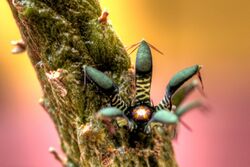Biology:Rhytidocaulon
From HandWiki
Short description: Genus of flowering plants
| Rhytidocaulon | |
|---|---|

| |
| Rhytidocaulon macrolobum | |
| Scientific classification | |
| Kingdom: | Plantae |
| Clade: | Tracheophytes |
| Clade: | Angiosperms |
| Clade: | Eudicots |
| Clade: | Asterids |
| Order: | Gentianales |
| Family: | Apocynaceae |
| Subfamily: | Asclepiadoideae |
| Tribe: | Ceropegieae |
| Genus: | Rhytidocaulon P.R.O.Bally |
Rhytidocaulon is a plant genus in the family Apocynaceae, first described in 1962.[1][2] It is native to northeastern Africa and the Arabian Peninsula
- Species
Species accepted by the Plants of the World Online as of February 2023:[3]
- Rhytidocaulon arachnoideum T.A.McCoy
- Rhytidocaulon baricum Thulin
- Rhytidocaulon ciliatum Hanácek & Ricánek
- Rhytidocaulon elegantissimum Hanácek & Ricánek
- Rhytidocaulon fulleri Lavranos & Mortimer
- Rhytidocaulon macrolobum Lavranos
- Rhytidocaulon mccoyi Lavranos & Mies
- Rhytidocaulon molamatarense T.A.McCoy & Plowes
- Rhytidocaulon paradoxum P.R.O.Bally - Ethiopia
- Rhytidocaulon piliferum Lavranos - Somalia
- Rhytidocaulon pseudosubscandens T.A.McCoy
- Rhytidocaulon richardianum Lavranos - Somalia
- Rhytidocaulon sheilae D.V.Field
- Rhytidocaulon specksii T.A.McCoy
- Rhytidocaulon splendidum T.A.McCoy
- Rhytidocaulon subscandens P.R.O.Bally - Somalia, Ethiopia
- Rhytidocaulon tortum (N.E.Br.) M.G.Gilbert - Arabia
- Taxonomy
Phylogenetic studies have shown the genus to be monophyletic, and most closely related to the genus Echidnopsis which inhabits the same region. Marginally more distantly related is a sister branch comprising the genus Pseudolithos and the widespread Caralluma stapeliads of North Africa.[4]
References
- ↑ Bally, Peter René Oscar. 1962. Candollea 18: 335
- ↑ Tropicos, genus Rhytidocaulon
- ↑ "Rhytidocaulon P.R.O.Bally". Royal Botanic Gardens, Kew. 2023. https://powo.science.kew.org/taxon/urn:lsid:ipni.org:names:331908-2.
- ↑ P. Bruyns, C. Klak, P. Hanacek: Evolution of the stapeliads (Apocynaceae-Asclepiadoideae) - repeated major radiation across Africa in an Old World group. Molecular Phylogenetics and Evolution. 2014. v. 77, no. 1, p. 251--263. ISSN 1055-7903.
Wikidata ☰ Q3429900 entry
 |

